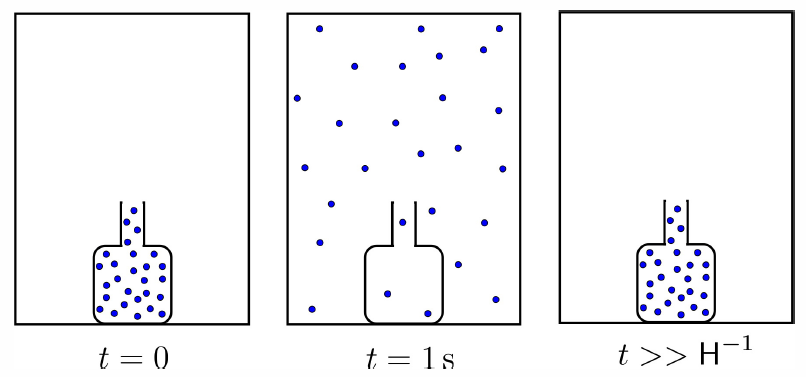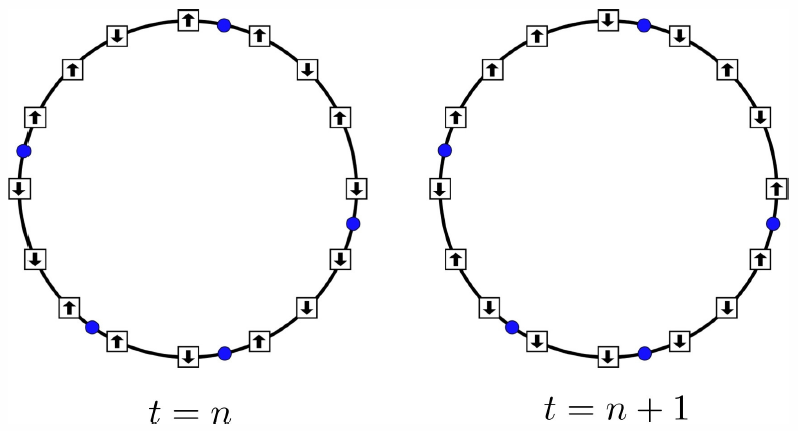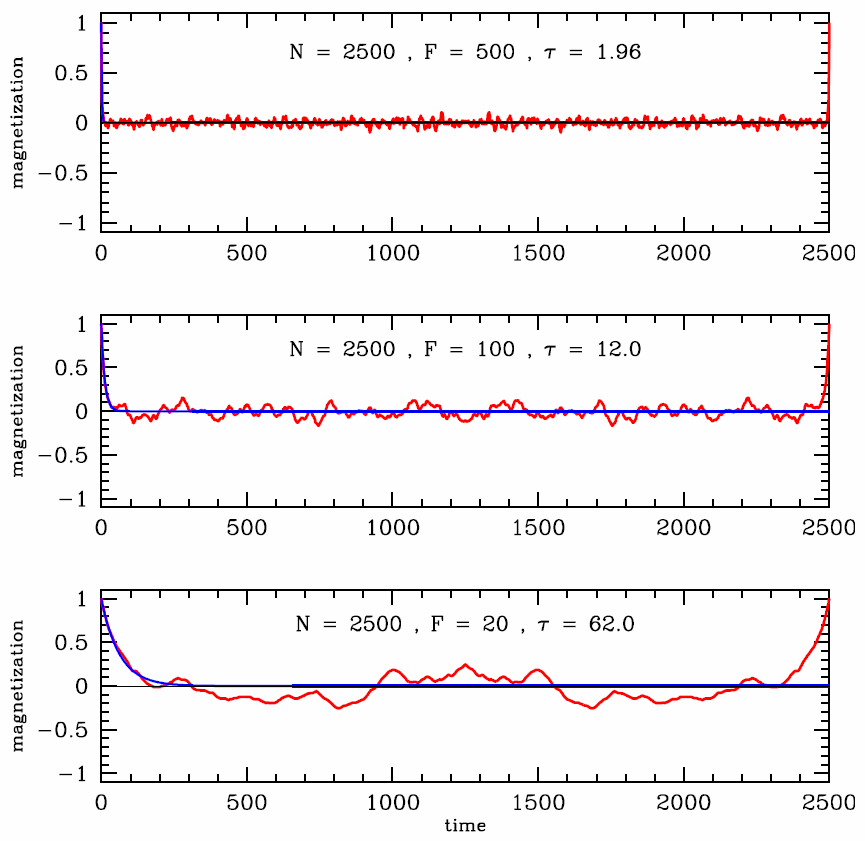3.3: Irreversibility and Poincaré Recurrence
( \newcommand{\kernel}{\mathrm{null}\,}\)
\( \newcommand\Dalpha
Callstack:
at (Template:MathJaxArovas), /content/body/div/p[1]/span[1], line 1, column 1
at template()
at (Bookshelves/Thermodynamics_and_Statistical_Mechanics/Book:_Thermodynamics_and_Statistical_Mechanics_(Arovas)/03:_Ergodicity_and_the_Approach_to_Equilibrium/3.03:_Irreversibility_and_Poincare_Recurrence), /content/body/p[1]/span, line 1, column 23
\( \newcommand\Dbeta
Callstack:
at (Template:MathJaxArovas), /content/body/div/p[1]/span[2], line 1, column 1
at template()
at (Bookshelves/Thermodynamics_and_Statistical_Mechanics/Book:_Thermodynamics_and_Statistical_Mechanics_(Arovas)/03:_Ergodicity_and_the_Approach_to_Equilibrium/3.03:_Irreversibility_and_Poincare_Recurrence), /content/body/p[1]/span, line 1, column 23
\( \newcommand\Dgamma
Callstack:
at (Template:MathJaxArovas), /content/body/div/p[1]/span[3], line 1, column 1
at template()
at (Bookshelves/Thermodynamics_and_Statistical_Mechanics/Book:_Thermodynamics_and_Statistical_Mechanics_(Arovas)/03:_Ergodicity_and_the_Approach_to_Equilibrium/3.03:_Irreversibility_and_Poincare_Recurrence), /content/body/p[1]/span, line 1, column 23
\( \newcommand\Ddelta
Callstack:
at (Template:MathJaxArovas), /content/body/div/p[1]/span[4], line 1, column 1
at template()
at (Bookshelves/Thermodynamics_and_Statistical_Mechanics/Book:_Thermodynamics_and_Statistical_Mechanics_(Arovas)/03:_Ergodicity_and_the_Approach_to_Equilibrium/3.03:_Irreversibility_and_Poincare_Recurrence), /content/body/p[1]/span, line 1, column 23
\( \newcommand\Depsilon
Callstack:
at (Template:MathJaxArovas), /content/body/div/p[1]/span[5], line 1, column 1
at template()
at (Bookshelves/Thermodynamics_and_Statistical_Mechanics/Book:_Thermodynamics_and_Statistical_Mechanics_(Arovas)/03:_Ergodicity_and_the_Approach_to_Equilibrium/3.03:_Irreversibility_and_Poincare_Recurrence), /content/body/p[1]/span, line 1, column 23
\( \newcommand\Dvarepsilon
Callstack:
at (Template:MathJaxArovas), /content/body/div/p[1]/span[6], line 1, column 1
at template()
at (Bookshelves/Thermodynamics_and_Statistical_Mechanics/Book:_Thermodynamics_and_Statistical_Mechanics_(Arovas)/03:_Ergodicity_and_the_Approach_to_Equilibrium/3.03:_Irreversibility_and_Poincare_Recurrence), /content/body/p[1]/span, line 1, column 23
\( \newcommand\Dzeta
Callstack:
at (Template:MathJaxArovas), /content/body/div/p[1]/span[7], line 1, column 1
at template()
at (Bookshelves/Thermodynamics_and_Statistical_Mechanics/Book:_Thermodynamics_and_Statistical_Mechanics_(Arovas)/03:_Ergodicity_and_the_Approach_to_Equilibrium/3.03:_Irreversibility_and_Poincare_Recurrence), /content/body/p[1]/span, line 1, column 23
\( \newcommand\Deta
Callstack:
at (Template:MathJaxArovas), /content/body/div/p[1]/span[8], line 1, column 1
at template()
at (Bookshelves/Thermodynamics_and_Statistical_Mechanics/Book:_Thermodynamics_and_Statistical_Mechanics_(Arovas)/03:_Ergodicity_and_the_Approach_to_Equilibrium/3.03:_Irreversibility_and_Poincare_Recurrence), /content/body/p[1]/span, line 1, column 23
\( \newcommand\Dtheta
Callstack:
at (Template:MathJaxArovas), /content/body/div/p[1]/span[9], line 1, column 1
at template()
at (Bookshelves/Thermodynamics_and_Statistical_Mechanics/Book:_Thermodynamics_and_Statistical_Mechanics_(Arovas)/03:_Ergodicity_and_the_Approach_to_Equilibrium/3.03:_Irreversibility_and_Poincare_Recurrence), /content/body/p[1]/span, line 1, column 23
\( \newcommand\Dvartheta
Callstack:
at (Template:MathJaxArovas), /content/body/div/p[1]/span[10], line 1, column 1
at template()
at (Bookshelves/Thermodynamics_and_Statistical_Mechanics/Book:_Thermodynamics_and_Statistical_Mechanics_(Arovas)/03:_Ergodicity_and_the_Approach_to_Equilibrium/3.03:_Irreversibility_and_Poincare_Recurrence), /content/body/p[1]/span, line 1, column 23
\( \newcommand\Diota
Callstack:
at (Template:MathJaxArovas), /content/body/div/p[1]/span[11], line 1, column 1
at template()
at (Bookshelves/Thermodynamics_and_Statistical_Mechanics/Book:_Thermodynamics_and_Statistical_Mechanics_(Arovas)/03:_Ergodicity_and_the_Approach_to_Equilibrium/3.03:_Irreversibility_and_Poincare_Recurrence), /content/body/p[1]/span, line 1, column 23
\( \newcommand\Dkappa
Callstack:
at (Template:MathJaxArovas), /content/body/div/p[1]/span[12], line 1, column 1
at template()
at (Bookshelves/Thermodynamics_and_Statistical_Mechanics/Book:_Thermodynamics_and_Statistical_Mechanics_(Arovas)/03:_Ergodicity_and_the_Approach_to_Equilibrium/3.03:_Irreversibility_and_Poincare_Recurrence), /content/body/p[1]/span, line 1, column 23
\( \newcommand\Dlambda
Callstack:
at (Template:MathJaxArovas), /content/body/div/p[1]/span[13], line 1, column 1
at template()
at (Bookshelves/Thermodynamics_and_Statistical_Mechanics/Book:_Thermodynamics_and_Statistical_Mechanics_(Arovas)/03:_Ergodicity_and_the_Approach_to_Equilibrium/3.03:_Irreversibility_and_Poincare_Recurrence), /content/body/p[1]/span, line 1, column 23
\( \newcommand\Dvarpi
Callstack:
at (Template:MathJaxArovas), /content/body/div/p[1]/span[14], line 1, column 1
at template()
at (Bookshelves/Thermodynamics_and_Statistical_Mechanics/Book:_Thermodynamics_and_Statistical_Mechanics_(Arovas)/03:_Ergodicity_and_the_Approach_to_Equilibrium/3.03:_Irreversibility_and_Poincare_Recurrence), /content/body/p[1]/span, line 1, column 23
\( \newcommand\DGamma
Callstack:
at (Template:MathJaxArovas), /content/body/div/p[1]/span[15], line 1, column 1
at template()
at (Bookshelves/Thermodynamics_and_Statistical_Mechanics/Book:_Thermodynamics_and_Statistical_Mechanics_(Arovas)/03:_Ergodicity_and_the_Approach_to_Equilibrium/3.03:_Irreversibility_and_Poincare_Recurrence), /content/body/p[1]/span, line 1, column 23
\( \newcommand\DDelta
Callstack:
at (Template:MathJaxArovas), /content/body/div/p[1]/span[16], line 1, column 1
at template()
at (Bookshelves/Thermodynamics_and_Statistical_Mechanics/Book:_Thermodynamics_and_Statistical_Mechanics_(Arovas)/03:_Ergodicity_and_the_Approach_to_Equilibrium/3.03:_Irreversibility_and_Poincare_Recurrence), /content/body/p[1]/span, line 1, column 23
\( \newcommand\DTheta
Callstack:
at (Template:MathJaxArovas), /content/body/div/p[1]/span[17], line 1, column 1
at template()
at (Bookshelves/Thermodynamics_and_Statistical_Mechanics/Book:_Thermodynamics_and_Statistical_Mechanics_(Arovas)/03:_Ergodicity_and_the_Approach_to_Equilibrium/3.03:_Irreversibility_and_Poincare_Recurrence), /content/body/p[1]/span, line 1, column 23
\( \newcommand\Vmu
Callstack:
at (Template:MathJaxArovas), /content/body/div/p[1]/span[18], line 1, column 1
at template()
at (Bookshelves/Thermodynamics_and_Statistical_Mechanics/Book:_Thermodynamics_and_Statistical_Mechanics_(Arovas)/03:_Ergodicity_and_the_Approach_to_Equilibrium/3.03:_Irreversibility_and_Poincare_Recurrence), /content/body/p[1]/span, line 1, column 23
\( \newcommand\Vnu
Callstack:
at (Template:MathJaxArovas), /content/body/div/p[1]/span[19], line 1, column 1
at template()
at (Bookshelves/Thermodynamics_and_Statistical_Mechanics/Book:_Thermodynamics_and_Statistical_Mechanics_(Arovas)/03:_Ergodicity_and_the_Approach_to_Equilibrium/3.03:_Irreversibility_and_Poincare_Recurrence), /content/body/p[1]/span, line 1, column 23
\( \newcommand\Vxi
Callstack:
at (Template:MathJaxArovas), /content/body/div/p[1]/span[20], line 1, column 1
at template()
at (Bookshelves/Thermodynamics_and_Statistical_Mechanics/Book:_Thermodynamics_and_Statistical_Mechanics_(Arovas)/03:_Ergodicity_and_the_Approach_to_Equilibrium/3.03:_Irreversibility_and_Poincare_Recurrence), /content/body/p[1]/span, line 1, column 23
\( \newcommand\Vom
Callstack:
at (Template:MathJaxArovas), /content/body/div/p[1]/span[21], line 1, column 1
at template()
at (Bookshelves/Thermodynamics_and_Statistical_Mechanics/Book:_Thermodynamics_and_Statistical_Mechanics_(Arovas)/03:_Ergodicity_and_the_Approach_to_Equilibrium/3.03:_Irreversibility_and_Poincare_Recurrence), /content/body/p[1]/span, line 1, column 23
\( \newcommand\Vpi
Callstack:
at (Template:MathJaxArovas), /content/body/div/p[1]/span[22], line 1, column 1
at template()
at (Bookshelves/Thermodynamics_and_Statistical_Mechanics/Book:_Thermodynamics_and_Statistical_Mechanics_(Arovas)/03:_Ergodicity_and_the_Approach_to_Equilibrium/3.03:_Irreversibility_and_Poincare_Recurrence), /content/body/p[1]/span, line 1, column 23
\( \newcommand\Vvarpi
Callstack:
at (Template:MathJaxArovas), /content/body/div/p[1]/span[23], line 1, column 1
at template()
at (Bookshelves/Thermodynamics_and_Statistical_Mechanics/Book:_Thermodynamics_and_Statistical_Mechanics_(Arovas)/03:_Ergodicity_and_the_Approach_to_Equilibrium/3.03:_Irreversibility_and_Poincare_Recurrence), /content/body/p[1]/span, line 1, column 23
\( \newcommand\Vrho
Callstack:
at (Template:MathJaxArovas), /content/body/div/p[1]/span[24], line 1, column 1
at template()
at (Bookshelves/Thermodynamics_and_Statistical_Mechanics/Book:_Thermodynamics_and_Statistical_Mechanics_(Arovas)/03:_Ergodicity_and_the_Approach_to_Equilibrium/3.03:_Irreversibility_and_Poincare_Recurrence), /content/body/p[1]/span, line 1, column 23
\( \newcommand\Vvarrho
Callstack:
at (Template:MathJaxArovas), /content/body/div/p[1]/span[25], line 1, column 1
at template()
at (Bookshelves/Thermodynamics_and_Statistical_Mechanics/Book:_Thermodynamics_and_Statistical_Mechanics_(Arovas)/03:_Ergodicity_and_the_Approach_to_Equilibrium/3.03:_Irreversibility_and_Poincare_Recurrence), /content/body/p[1]/span, line 1, column 23
\( \newcommand\Vsigma
Callstack:
at (Template:MathJaxArovas), /content/body/div/p[1]/span[26], line 1, column 1
at template()
at (Bookshelves/Thermodynamics_and_Statistical_Mechanics/Book:_Thermodynamics_and_Statistical_Mechanics_(Arovas)/03:_Ergodicity_and_the_Approach_to_Equilibrium/3.03:_Irreversibility_and_Poincare_Recurrence), /content/body/p[1]/span, line 1, column 23
\( \newcommand\Vvarsigma
Callstack:
at (Template:MathJaxArovas), /content/body/div/p[1]/span[27], line 1, column 1
at template()
at (Bookshelves/Thermodynamics_and_Statistical_Mechanics/Book:_Thermodynamics_and_Statistical_Mechanics_(Arovas)/03:_Ergodicity_and_the_Approach_to_Equilibrium/3.03:_Irreversibility_and_Poincare_Recurrence), /content/body/p[1]/span, line 1, column 23
\( \newcommand\Vtau
Callstack:
at (Template:MathJaxArovas), /content/body/div/p[1]/span[28], line 1, column 1
at template()
at (Bookshelves/Thermodynamics_and_Statistical_Mechanics/Book:_Thermodynamics_and_Statistical_Mechanics_(Arovas)/03:_Ergodicity_and_the_Approach_to_Equilibrium/3.03:_Irreversibility_and_Poincare_Recurrence), /content/body/p[1]/span, line 1, column 23
\( \newcommand\Vupsilon
Callstack:
at (Template:MathJaxArovas), /content/body/div/p[1]/span[29], line 1, column 1
at template()
at (Bookshelves/Thermodynamics_and_Statistical_Mechanics/Book:_Thermodynamics_and_Statistical_Mechanics_(Arovas)/03:_Ergodicity_and_the_Approach_to_Equilibrium/3.03:_Irreversibility_and_Poincare_Recurrence), /content/body/p[1]/span, line 1, column 23
\( \newcommand\Vphi
Callstack:
at (Template:MathJaxArovas), /content/body/div/p[1]/span[30], line 1, column 1
at template()
at (Bookshelves/Thermodynamics_and_Statistical_Mechanics/Book:_Thermodynamics_and_Statistical_Mechanics_(Arovas)/03:_Ergodicity_and_the_Approach_to_Equilibrium/3.03:_Irreversibility_and_Poincare_Recurrence), /content/body/p[1]/span, line 1, column 23
\( \newcommand\Vvarphi
Callstack:
at (Template:MathJaxArovas), /content/body/div/p[1]/span[31], line 1, column 1
at template()
at (Bookshelves/Thermodynamics_and_Statistical_Mechanics/Book:_Thermodynamics_and_Statistical_Mechanics_(Arovas)/03:_Ergodicity_and_the_Approach_to_Equilibrium/3.03:_Irreversibility_and_Poincare_Recurrence), /content/body/p[1]/span, line 1, column 23
\( \newcommand\Vchi
Callstack:
at (Template:MathJaxArovas), /content/body/div/p[1]/span[32], line 1, column 1
at template()
at (Bookshelves/Thermodynamics_and_Statistical_Mechanics/Book:_Thermodynamics_and_Statistical_Mechanics_(Arovas)/03:_Ergodicity_and_the_Approach_to_Equilibrium/3.03:_Irreversibility_and_Poincare_Recurrence), /content/body/p[1]/span, line 1, column 23
\( \newcommand\Vpsi
Callstack:
at (Template:MathJaxArovas), /content/body/div/p[1]/span[33], line 1, column 1
at template()
at (Bookshelves/Thermodynamics_and_Statistical_Mechanics/Book:_Thermodynamics_and_Statistical_Mechanics_(Arovas)/03:_Ergodicity_and_the_Approach_to_Equilibrium/3.03:_Irreversibility_and_Poincare_Recurrence), /content/body/p[1]/span, line 1, column 23
\( \newcommand\Vomega
Callstack:
at (Template:MathJaxArovas), /content/body/div/p[1]/span[34], line 1, column 1
at template()
at (Bookshelves/Thermodynamics_and_Statistical_Mechanics/Book:_Thermodynamics_and_Statistical_Mechanics_(Arovas)/03:_Ergodicity_and_the_Approach_to_Equilibrium/3.03:_Irreversibility_and_Poincare_Recurrence), /content/body/p[1]/span, line 1, column 23
\( \newcommand\VGamma
Callstack:
at (Template:MathJaxArovas), /content/body/div/p[1]/span[35], line 1, column 1
at template()
at (Bookshelves/Thermodynamics_and_Statistical_Mechanics/Book:_Thermodynamics_and_Statistical_Mechanics_(Arovas)/03:_Ergodicity_and_the_Approach_to_Equilibrium/3.03:_Irreversibility_and_Poincare_Recurrence), /content/body/p[1]/span, line 1, column 23
\( \newcommand\VDelta
Callstack:
at (Template:MathJaxArovas), /content/body/div/p[1]/span[36], line 1, column 1
at template()
at (Bookshelves/Thermodynamics_and_Statistical_Mechanics/Book:_Thermodynamics_and_Statistical_Mechanics_(Arovas)/03:_Ergodicity_and_the_Approach_to_Equilibrium/3.03:_Irreversibility_and_Poincare_Recurrence), /content/body/p[1]/span, line 1, column 23
\newcommand\BI{\mib I}}
\)
\newcommand { M}
\newcommand { m}
}
\( \newcommand\tcb{\textcolor{blue}\)
\( \newcommand\tcr{\textcolor{red}\)
1$#1_$
\newcommand\SZ{\textsf Z}} \( \newcommand\kFd{k\ns_{\RF\dar}\)
\newcommand\mutB{\tilde\mu}\ns_\ssr{B}
\( \newcommand\xhihOZ
Callstack:
at (Template:MathJaxArovas), /content/body/div/span[1], line 1, column 1
at template()
at (Bookshelves/Thermodynamics_and_Statistical_Mechanics/Book:_Thermodynamics_and_Statistical_Mechanics_(Arovas)/03:_Ergodicity_and_the_Approach_to_Equilibrium/3.03:_Irreversibility_and_Poincare_Recurrence), /content/body/p[1]/span, line 1, column 23
\( \newcommand\labar
Callstack:
at (Template:MathJaxArovas), /content/body/div/span[2], line 1, column 1
at template()
at (Bookshelves/Thermodynamics_and_Statistical_Mechanics/Book:_Thermodynamics_and_Statistical_Mechanics_(Arovas)/03:_Ergodicity_and_the_Approach_to_Equilibrium/3.03:_Irreversibility_and_Poincare_Recurrence), /content/body/p[1]/span, line 1, column 23
The dynamics of the master equation describe an approach to equilibrium. These dynamics are irreversible: dH/dt≤0, where H is Boltzmann’s H-function. However, the microscopic laws of physics are (almost) time-reversal invariant4, so how can we understand the emergence of irreversibility? Furthermore, any dynamics which are deterministic and volume-preserving in a finite phase space exhibits the phenomenon of Poincaré recurrence, which guarantees that phase space trajectories are arbitrarily close to periodic if one waits long enough.
Poincaré Recurrence Theorem
The proof of the recurrence theorem is simple. Let gτ be the ‘τ-advance mapping’ which evolves points in phase space according to Hamilton’s equations. Assume that gτ is invertible and volume-preserving, as is the case for Hamiltonian flow. Further assume that phase space volume is finite. Since energy is preserved in the case of time-independent Hamiltonians, we simply ask that the volume of phase space at fixed total energy E be finite,
∫dμδ(E−H(q,p))<∞ ,
where dμ=dqdp is the phase space uniform integration measure.
In any finite neighborhood R∗0 of phase space there exists a point φ†0 which will return to R∗0 after m applications of gτ, where m is finite.

Assume the theorem fails; we will show this assumption results in a contradiction. Consider the set Υ formed from the union of all sets gkτR for all m:
Υ=∞⋃k=0gkτR∗0
We assume that the set {gkτR∗0|k∈N} is disjoint5. The volume of a union of disjoint sets is the sum of the individual volumes. Thus,
vol(Υ)=∞∑k=0vol(gkτR∗0)=vol(R∗0)⋅∞∑k=01=∞ ,
since vol(gkτR∗0)=vol(R∗0) from volume preservation. But clearly Υ is a subset of the entire phase space, hence we have a contradiction, because by assumption phase space is of finite volume.
Thus, the assumption that the set {gkτR∗0|k∈Z∗+} is disjoint fails. This means that there exists some pair of integers k and l, with k≠l, such that gkτR∗0∩glτR∗0≠∅. Without loss of generality we may assume k<l. Apply the inverse g−1τ to this relation k times to get gl−kτR∗0∩R∗0≠∅. Now choose any point φ∗1∈gmτR∗0∩R∗0, where m=l−k, and define φ†0=g−mτφ∗1. Then by construction both φ†0 and gmτφ†0 lie within R∗0 and the theorem is proven.
Poincaré recurrence has remarkable implications. Consider a bottle of perfume which is opened in an otherwise evacuated room, as depicted in Figure 3.3.2. The perfume molecules evolve according to Hamiltonian evolution. The positions are bounded because physical space is finite. The momenta are bounded because the total energy is conserved, hence no single particle can have a momentum such that T(p)>E∗TOT, where T(p) is the single particle kinetic energy function6. Thus, phase space, however large, is still bounded. Hamiltonian evolution, as we have seen, is invertible and volume preserving, therefore the system is recurrent. All the molecules must eventually return to the bottle. What’s more, they all must return with momenta arbitrarily close to their initial momenta!7 In this case, we could define the region R∗0 as
R∗0={(q∗1,…,q∗r,p∗1,…,p∗r) | |q∗i−q0i|≤Δq and |p∗j−p0j|≤Δp ∀ i,j} ,
which specifies a hypercube in phase space centered about the point (q0,p0).

Each of the three central assumptions – finite phase space, invertibility, and volume preservation – is crucial. If any one of these assumptions does not hold, the proof fails. Obviously if phase space is infinite the flow needn’t be recurrent since it can keep moving off in a particular direction. Consider next a volume-preserving map which is not invertible. An example might be a mapping f:R→R which takes any real number to its fractional part. Thus, f(π)=0.14159265…. Let us restrict our attention to intervals of width less than unity. Clearly f is then volume preserving. The action of f on the interval [2,3) is to map it to the interval [0,1). But [0,1) remains fixed under the action of f, so no point within the interval [2,3) will ever return under repeated iterations of f. Thus, f does not exhibit Poincaré recurrence.
Consider next the case of the damped harmonic oscillator. In this case, phase space volumes contract. For a one-dimensional oscillator obeying ¨x+2β˙x+Ω20x=0 one has ∇⋅V=−2β<0, since β>0 for physical damping. Thus the convective derivative is Dtϱ=−(∇⋅V)ϱ=2βϱ which says that the density increases exponentially in the comoving frame, as ϱ(t)=e2βtϱ(0). Thus, phase space volumes collapse: Ω(t)=e−2β2Ω(0), and are not preserved by the dynamics. The proof of recurrence therefore fails. In this case, it is possible for the set Υ to be of finite volume, even if it is the union of an infinite number of sets gkτR∗0, because the volumes of these component sets themselves decrease exponentially, as vol(gnτR∗0)=e−2nβτvol(R∗0). A damped pendulum, released from rest at some small angle θ†0, will not return arbitrarily close to these initial conditions.
Kac ring model
The implications of the Poincaré recurrence theorem are surprising – even shocking. If one takes a bottle of perfume in a sealed, evacuated room and opens it, the perfume molecules will diffuse throughout the room. The recurrence theorem guarantees that after some finite time T all the molecules will go back inside the bottle (and arbitrarily close to their initial velocities as well). The hitch is that this could take a very long time, much much longer than the age of the Universe.
On less absurd time scales, we know that most systems come to thermodynamic equilibrium. But how can a system both exhibit equilibration and Poincaré recurrence? The two concepts seem utterly incompatible!
A beautifully simple model due to Kac shows how a recurrent system can exhibit the phenomenon of equilibration. Consider a ring with N sites. On each site, place a ‘spin’ which can be in one of two states: up or down. Along the N links of the system, F of them contain ‘flippers’. The configuration of the flippers is set at the outset and never changes. The dynamics of the system are as follows: during each time step, every spin moves clockwise a distance of one lattice spacing. Spins which pass through flippers reverse their orientation: up becomes down, and down becomes up.

The ‘phase space’ for this system consists of 2N discrete configurations. Since each configuration maps onto a unique image under the evolution of the system, phase space ‘volume’ is preserved. The evolution is invertible; the inverse is obtained simply by rotating the spins counterclockwise. Figure 3.3.3 depicts an example configuration for the system, and its first iteration under the dynamics.

Suppose the flippers were not fixed, but moved about randomly. In this case, we could focus on a single spin and determine its configuration probabilistically. Let pn be the probability that a given spin is in the up configuration at time n. The probability that it is up at time (n+1) is then
pn+1=(1−x)pn+x(1−pn) ,
where x=F/N is the fraction of flippers in the system. In words: a spin will be up at time (n+1) if it was up at time n and did not pass through a flipper, or if it was down at time n and did pass through a flipper. If the flipper locations are randomized at each time step, then the probability of flipping is simply x=F/N. Equation ??? can be solved immediately:
pn=12+(1−2x)n(p0−12) ,
which decays exponentially to the equilibrium value of p†eq=12 with time scale
τ(x)=−1ln|1−2x| .
We identify τ(x) as the microscopic relaxation time over which local equilibrium is established. If we define the magnetization m≡(N†↑−N†↓)/N, then m=2p−1, so mn=(1−2x)nm0. The equilibrium magnetization is m†eq=0. Note that for 12<x<1 that the magnetization reverses sign each time step, as well as decreasing exponentially in magnitude.

The assumption that leads to equation ??? is called the Stosszahlansatz8, a long German word meaning, approximately, ‘assumption on the counting of hits’. The resulting dynamics are irreversible: the magnetization inexorably decays to zero. However, the Kac ring model is purely deterministic, and the Stosszahlansatz can at best be an approximation to the true dynamics. Clearly the Stosszahlansatz fails to account for correlations such as the following: if spin i is flipped at time n, then spin i+1 will have been flipped at time n−1. Also if spin i is flipped at time n, then it also will be flipped at time n+N. Indeed, since the dynamics of the Kac ring model are invertible and volume preserving, it must exhibit Poincaré recurrence. We see this most vividly in Figures 3.3.4 and 3.3.5.
The model is trivial to simulate. The results of such a simulation are shown in Figure 3.3.4 for a ring of N=1000 sites, with F=100 and F=24 flippers. Note how the magnetization decays and fluctuates about the equilibrium value m†eq=0, but that after N iterations m recovers its initial value: m†N=m†0. The recurrence time for this system is simply N if F is even, and 2N if F is odd, since every spin will then have flipped an even number of times.
In Figure 3.3.5 we plot two other simulations. The top panel shows what happens when x>12, so that the magnetization wants to reverse its sign with every iteration. The bottom panel shows a simulation for a larger ring, with N=25000 sites. Note that the fluctuations in m about equilibrium are smaller than in the cases with N=1000 sites. Why?


